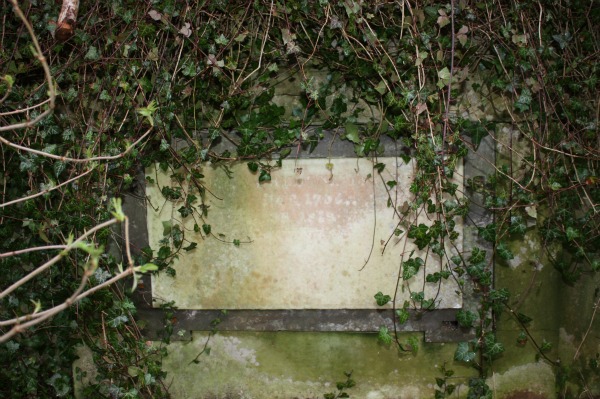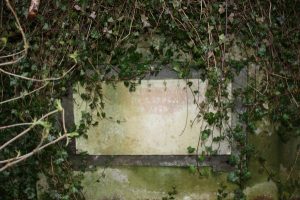Middle – Lennel Kirk Internal – 27 – Brydone
Transcription
(Inside south wall) PATRICK BRYDONE Esqr FRS born 1736 died 1818.
Commentary
Patrick Brydone and Robert Burns 1787.
Robert Burns (1759-1796), the Scottish National Bard visited Coldstream in May 1787. Before leaving Edinburgh, Burns bought himself a horse which he named ‘Jenny Geddes’, in respect for a lady who threw a stool at the Bishop of Edinburgh when he tried to force the Scottish Church to accept the ‘Book of Common Payer’. On the Saturday 5 May 1787), Burns and his companion Ainslie left Edinburgh and the first destination of the two friends was Duns and the route they followed was through Haddington, Gifford and Longformacus. During his tour Burns used a notebook and was apt to insert notes at appropriate intervals. For example, ‘The Lammermuir Hills were miserably dreary’ but as he approached Duns he had a ‘glorious view of the Merse’ before reaching Berrywell, the home of the Ainslie’s, the family of Robert Ainslie. For those interested in Burns, Duns Burns club has erected a cairn on the Hardens Hill to commemorate Burns passing by. Burns spent his first night with the Ainslie family and some of their friends, and he noted in his diary that he accompanied the Ainslies to the morning service in the local parish church. The Reverend Robert Bowmaker had chosen as the text for his sermon a severe denunciation of obstinate sinners. The poet, observing that Rachel Ainslie was having difficulty finding the text in the Bible, wrote and passed her the following note:-
‘Fair Maid, you need not take the hint. Nor idle text pursue, ‘Twas guilty sinners that he meant. Not angels such as you’
The Bard’s companion, Robert Ainslie, was born at Berrywell, and later became a Writer to the Signet in 1789. Burns introduced Ainslie to many of the leading Edinburgh gentry and became a firm friend of Burns. Sometime before he died in 1838, he presented Sir Walter Scott with a manuscript copy of ‘Tam O’ Shanter’ which he had received from Burns. Robert Burns is named on the tombstone of the Ainslie family in the churchyard at Duns. It was Coldstream’s turn to receive Burns on Monday 7 May 1787 when the Bard wrote in his diary:-
‘Coldstream, went over to England – Cornhill – glorious Tweed – clear and majestic – fine bridge – dine at Coldstream with Mr. Ainslie and Mr Foreman – beat Mr.F in a dispute about Voltaire. Tea at Lennel House with MrBrydone. Mr.Brydone a most excellent heart, kind, joyous and benevolent; but a good deal of the French indiscriminate complaisance – from his situation past and present, an admirer of everything that bears a splendid title, or that possesses a large estate. Mrs Brydone a most elegant woman in her person and manners; the tones of her voice remarkably sweet – my reception extremely flattering – sleep at Coldstream’.
The bridge referred to by Burns is of course the Coldstream Bridge which was built by Smeaton. Robert Ainslie told the story of how when he and Burns crossed the Smeaton Bridge, setting foot on English soil for the first time, the Bard doffed his blue bonnet and, kneeling on the turf by the roadside, prayed and invoked a blessing on Scotland, using the last two stanzas of his classic poem ‘The Cotter’s Saturday Night’:-
‘O Scotia My Dear, my native soil, For whom my warmest wish to heaven is sent. Long may thy hardy sons of rustic toil, be blest with health, and peace and sweet content. And o may heaven their simple lives prevent. Form luxury’s contagion, weak and vile. The howe’er crowns and coronets be rent, A virtuous populace may rise the while, And stand a wall of fire round our much-loved isle. Oh Thou! Who pour’d the patriotic tide. That streamed thro’ Wallace’s undaunted heart. Who dared to, nobly stem tyrannic pride. Or nobly die – the second glorious part. (The patriots’s God, peculiarly thou art His friend, inspirer, guardian and reward). O never, never, Scotia’s realm desert. But still the patriot, and the patriot-bard. In bright sucession raise, her ornament and guard’
The story about Burns and the dedication to Scotland at the Coldstream Bridge was sent by Ainslie to James Hogg the Ettrick shepherd in a letter dated 20 April 1834, some 48 years after the event was supposed to have taken place. Because of the great lapse in time taken by Robert Ainslie to relate the story, and the fact that Burns made no note or comment about it, there are some who believe that this event may not have taken place. Nevertheless a Border Magazine of 1906 reported on the event and said that:
‘It is recorded that Mr Ainslie kept silent, uncertain what was next to be done, when Burns, with extreme emotion, and an expression of countenance which his companion could never forget, prayed for and blessed Scotland solemnly, by pronouncing aloud, in tones of deepest devotion the two stanzas of ‘The Cotter’s Saturday Night’.
An article in the Berwickshire News of 1959 (200th anniversary of Burns’s birth) refers to a poem written by Burns on the state of Berwickshire’s roads:-
I’ve now arrived, thanks to the Gods,
Thru’ pathways rough and muddy,
A certain sign that making roads
Is no the people’s study
Although I’m no’ wi’ scripture crammed
I’m sure the bible says
That heedless sinners shall be damned
Unless they mend their ways.
Maurice Lindsay, in his biography, suggests that Burns crossing the Bridge and reciting from the ‘Cotter’s Saturday Night’ is absurd and he wonders why it was not mentioned in Burns’s notebook and questions the reliance of Ainslie. Whatever the truth of Burns and the Coldstream bridge, the legend lives on. Mr Foreman was a farmer in the locality of Coldstream and the dispute that Burns says he won was about the great French philosopher Francois Marie Arouet de Voltaire. Burns left Coldstream for Kelso on Tuesday 8 May 1787, never to return. His visit to the town was fleeting, but marked, and there is no reference to where he slept in Coldstream, or what he thought of Coldstream.
Patrick Brydone
Patrick Brydone FRS, of Lennel House, was born in Dumbarton in 1741 and was educated at Glasgow. He was a son of Robert Brydone, Parish Minister of Coldingham. Having received an excellent university education, which qualified him for the duties of a travelling preceptor (a specialist teacher), he was engaged in that capacity, first by a Mr Beckford of Somerly in Suffolk and afterwards by Mr Fullarton, who commanded a large body of troops in India and became one of the three commissioners for the government of Trinidad. His excursion with the former gentleman took place in 1767-68; the latter in 1770. In the second tour, he visited Sicily and Malta, which were then almost unknown to the UK. Having written an account of this journey in a series of letters to Mr Beckford, he was induced by the uninformed state of the British public upon this subject to publish his work in 1773 under the title ‘A Tour through Sicily and Malta’. This work was not only a most original and amusing narrative, but it contained a great deal of scientific knowledge, especially regarding the temperature of the air, which was the object of Mr Brydone’s original study. The account was republished in many new editions, and was translated into French and German. To transact his scientific observations, he travelled with an apparatus as perfect as could then be purchased, or could be accommodated in the luggage of a traveller. Having returned to England in 1771, he obtained a respectable appointment, and at one time he held the office of Controller of the Stamp Office.
After the publication of his travels, his reputation and prestige heightened and he was nominated a member of some learned societies, particularly the Royal Society of London. In the transactions of this latter body were several papers of Patrick Brydone, chiefly on the subject of electricity, of which he was a keen student and observer. He spent the latter part of his life in retirement, at Lennel House, where he was visited by the many distinguished persons in literature and public life, including of course Robert Burns. Mrs Brydone was a daughter of Doctor Robertson, a noted historian. Within the walls of the now dilapidated Lennel Church is to be found the burial place of Patrick Brydone, who passed away in 1818 at the age of 77 years. For the most part, Brydone is still profusely quoted on Maltese tourist web-sites, one such quote, Lord Patrick Brydone wrote when he visited Malta in the 1770s, ‘We found ourselves in a new world; the streets were crowded with well dressed people, whereas at Syracuse there was scarce a creature to be seen and even those few had the appearance of disease and wretchedness’.
After the publication of his book in the form of letters, people started visiting Palermo, Mount Etna etc. as part of the Grand Tour. In St Juliens (Malta), there is a street named after him. Moreover, Sir Walter Scott encouraged Brydone to publish his letters, and honours him in Marmion:
Where Lennel’s convent closed their march,
There now is left but one frail arch,
Yet mourn thou not its cells;
Our time a fair exchange has made;
Hard by, inhospitable shade,
A reverend pilgrim dwells,
Well worth the whole Bernardine brood,
That e’er wore sandal, frock or hood.
Andrew Geddes painted his portrait in oils, from which an engraving was made. In the Statistical Account 1791-1799 it is recorded that a ‘very remarkable thunder-storm happened in this parish on the 19th day of July; a very accurate and scientific account of which, by Captain Brydone, is to be found in the Philosophical Transactions of London’. (See a later reference to the ‘Curious Effect at Coldstream’).


